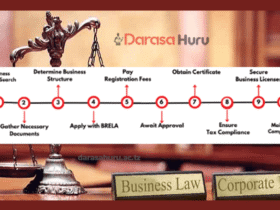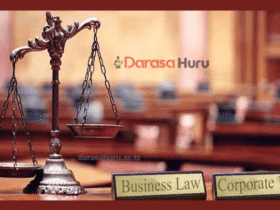Chapter Three: Financing Medium-Sized Businesses – Business Studies Form Five
Introduction
Normally, businesses are established and operated by individuals or groups of individuals with the main objective of generating profits. In particular, one of the factors to be considered before establishing a business is the way it can be financed.
In this chapter, you will learn about the concept of medium-sized businesses, and sources of financing for the medium-sized businesses. The competences developed will enable you to acquire financial support from different sources to establish and run the medium-sized businesses.
The Concept of Medium-Sized Businesses
Universally, there is no single accepted definition of medium-sized businesses. However, nations use different measures of size to define medium-sized businesses depending on their level of development. The Tanzania Small and Medium Enterprise (SME) Development Policy of 2003 recognises four categories of businesses namely: micro, small, medium, and large-scale enterprises.
Medium-sized businesses are based on the following features:
1. Number of employees
Medium-sized businesses employ 50 to 99 people who are engaged in various business activities like production and marketing of products as well as business support services such as accounting and human resources management.
2. Capital invested
Medium-sized businesses invest capital which range from TShs. 200 million to TShs. 800 million.
3. Operations
Medium-sized businesses employees are divided into different sections of operations like production, marketing, finance, information technology, procurement, and human resources that lead them to perform the assigned duties or activities.
4. Proprietorship
Medium-sized businesses may be owned by an individual, groups of individuals, family members as well as the public who have a common interest to ensure pre-determined goals are achieved.
Generally, medium-sized businesses are businesses whose number of employees and capital invested fall under well-defined limits depending on a country’s SME policy.
Importance of Medium-Sized Businesses
The following are the importance of the medium-sized businesses:
1. Creates employment
Medium-sized businesses employ a relatively large number of people to carry out various business activities. The number of people employed is usually large compared to small businesses. For example, in Tanzania medium enterprises employ from 50 to 99 people.
2. Faster decision-making
Medium-sized businesses decisions can be made by a single person or group of persons unlike large enterprises. This enables the businesses to reach conclusions on various matters timely.
3. Easy sharing of information
Medium-sized businesses communication process is easier compared to large businesses since management and employees are closer due to its smaller size. This enables information to flow smoothly and problems are addressed timely by people working together as a team.
4. Enhances growth of the economy
Medium-sized businesses contribute to the country’s economic growth through payment of different taxes which are used in the provision of public services. They also facilitate the supply of products for consumption, boost exports, and enable investment in other economic sectors.
5. Cost effectiveness
Medium-sized businesses are likely to have lower operational costs compared to large businesses due to their scale of operations. This enables them to have proper allocation of resources and efficiency in business operations and management.
6. Easy access to resources
Medium-sized businesses have better access to resources including finance compared to small businesses. Such access facilitates medium-sized businesses to grow and pursue more business opportunities to foster optimum business performance.
7. Closer relationship with customers
Medium-sized businesses can provide satisfactory customer services than larger-sized businesses due to their smaller customer base. They have the capacity to develop strong personalised relationships with customers, understand their demand and receive unique feedback from them.
Activity 1
Visit at least five businesses in your locality, and consult the owners or managers concerned on the detailed information related to features of those businesses. After consultation, use size metrics or indicators provided in the Tanzania SME Development Policy of 2003 to categorise those businesses.
Exercise 1
- Suppose you are invited to talk to a group of entrepreneurs who are not familiar with medium-sized businesses. Which issues will you talk to them?
- Suppose you are the owner of a particular medium-sized business. How can you compare your business to other categories of businesses?
Sources of Financing for Medium-Sized Businesses
Business enterprises need money for conducting different activities including buying raw materials, paying labours, or other production costs, and operational costs. Commonly, financing a business is essential as it assists the business to reach its pre-arranged goals.
Thus; without finance, the business will not be able to engage in production and realize its objectives. Medium-sized businesses are either financed by the owner (s), other people or organisations outside the business.
There are various sources of finance for medium-sized businesses. These sources of finance are grouped into two main categories; internal and external sources. Some sources of financing for medium-sized businesses are shown in Table 1.
| Internal sources | External sources |
|---|---|
| (a) Retained earnings | (a) Share capital |
| (b) Sale of non-current assets | (b) Venture capital |
| (c) Leasing of non-current assets | (c) Overdrafts |
| (d) Sale and leaseback of non-current assets | (d) Secured loans |
| (e) Debentures | |
| (f) Crowd funding | |
| (g) Grants |
I. Internal Sources of Finance
The internal funding of a business is acquired within the business without any support from outside. Some internal sources of finance include retained earnings, sale of non-current assets, leasing of non-current assets, and sale and leaseback of non-current assets which are explained as follows:
1. Retained Earnings
Retained earnings are also termed as undistributable profit. These are profits obtained in the business that are not distributed to owners as returns on their investment. Medium-sized business owners may decide to reallocate some of the undistributable profits gained from the business to enhance efficiency and effectiveness in their business operations. Retained earnings are typically contemplated as further finance for better business growth in the future. Higher retained earnings indicate that a business is financially healthier.
Medium-sized enterprises benefit from retained earnings as they are free cashflow that is not repaid. As opposed to loans, retained earnings have no issue costs and no interest rate to be repaid by the business as they are profit reserves generated in the business operations. Retained earnings also provide flexibility to business owners in reallocating resources to different operations.
However, some of the challenges of this source of funds in supporting medium-sized businesses include its inadequacy to support operations and future expansions if the medium-sized business entirely depends on it. This in turn may lead to poor business performance, which is unlikely to attract external investors hence the inability to raise additional capital.
2. Sale of Non-Current Assets
Non-current assets are the assets whose economic benefits are expected to be harnessed for a long time to support business operations. Some of the non-current assets include land, plant, equipment, vehicles, and other properties. Sale of non-current assets is another source of financing for medium-sized businesses whereby business owners dispose some of their idle assets. Sale of idle assets is a way of changing unproductive tangible assets into cash.
The medium-sized business may sell idle or unproductive assets to raise finance that may be used for various productive business activities or opportunities. However, the business should evaluate the outcomes before making a decision to sell some of its non-current assets. Income generated by the business from the disposal of idle non-current assets can be reinvested back into the business.
From sale of non-current assets, the business acquires funds without incurring debt, and no interest is charged. It also saves some costs to business enterprises that may be used for repairing and maintaining redundant assets.
However, the sale of non-current assets decreases the assets which could be used by the business in the future. It also takes time to find the right buyer, something which leads to delaying the availability of funds needed to conduct the business operations.
3. Leasing of Non-Current Assets
This refers to an agreement in which one party allows another party to use the non-current assets and return them after the specified time period. The asset owner is known as “lessor” meanwhile the person that uses the leased assets is called “lessee”.
In leasing, the terms and conditions that regulate agreements are outlined in a contract between the parties involved. There must be periodic payment by the lessee to the owner for the use of the assets. For this case, the medium-sized businesses will be obtaining cash after leasing their assets to other parties that will increase business finance.
Leasing of non-current assets does not add the business debts; instead, it creates more access of finance needed for business operation and expansion. In addition, lease of non-current assets enables the lessor to repossess the asset (s) that may be productive to the business when the lessee returns them after the agreed time.
However, leasing non-current assets is not convenient to newly established businesses as they might not have redundant assets to lease. Another challenge is that the lessor temporarily loses the ownership and will have no control over the property until the agreed period between the two parties comes to an end. Again, leasing of non-current assets in business leads to wear and tear which causes a shorter life span of those assets.
4. Sale and Leaseback of Non-Current Assets
Sale and leaseback of non-current assets refers to the process whereby the asset owner sells some of their assets to another party then the assets are promptly leased back from the buyer. Periodic payments (rental expenses) are made by the business entity to the owner for the use of an asset for an agreed time.
Bearing of repair and maintenance expenses depends on the agreement between two parties involved. Sale and leaseback benefit to the medium-sized enterprises by enabling the business venture to acquire both cash and assets that are used for various business operations. In this case, the business will continue to use the assets either for production or other business activities. However, this source of funding has some weaknesses like loss of ownership and control over the assets.
Exercise 2
- Kichochi decided to leave his job as a sales manager of TX company to start his own medium-sized business. Explain the reasons why Kichochi might resort to seeking finance to set up his new business enterprise.
- Suppose you own a business selling and distributing second-hand motor vehicles within Dar es Salaam. Due to the good performance of your business, you made a plan to expand it by opening new branches outside the region, however, you do not have enough capital to support your initiative. Which sources of finance would you use and why?
- The TIE catering business has been operating for almost six years in Tanzania Institute of Education. The business owner intends to increase capital by selling some of his assets. Explain to TIE’s catering owner or the management the benefits of using business profits as a source of finance rather than selling some of the assets.
II. External Sources of Finance
External funding of a business refers to finances provided by individuals or group of people outside the business venture. These include share capital, venture capital, overdrafts, secured loans, debentures, crowd funding and grants.
1. Share Capital
Share capital also known as equity finance, is one of the ways of financing medium-sized businesses mostly used by new business enterprises. Share capital refers to the means of raising capital by selling shares to investors.
The business increases finance by its capital through selling ownership (share) to investors. Shareholders are given rights to ownership and may have control in the management of the business. Shareholders receive dividends and capital gain (capital growth) as returns of their investment in the business.
Share capital benefits businesses by allowing an enterprise to raise finance without incurring debts as there is no payment of interest that adds the cost of the finance like bonds and loans. Share capital enables the medium-sized businesses to raise substantial amount of finance to undertake its operations.
Moreover, this approach brings in new shareholders who may add on valuable expertise to the business operations and meeting various expenditures. Despite the advantages of share capital financing, selling of shares to raise business finance usually results in ownership dilution for existing shareholders.
Ownership dilution occurs when the existing shareholders or business owners lose part of control over the business in case the new shareholders have come with new interests and preferences. It also leads to a loss of business secrecy as the new shareholders gain portion of ownership and control of the business.
2. Venture Capital
Venture capitalists are professional investors who may be wealthy investors, investment banks, or other financial institutions. Depending on the stage of business enterprises, they can have 25 per cent to 50 per cent of ownership in invested businesses. Venture capital financing is a way of raising funds from private equity investor (s) or venture capitalists for business enterprises with high growth potential in exchange for equity.
Venture capitalists expect to get above-average returns from their investments; hence, they invest in high-risk and potentially high-return businesses. Venture capital funding is suitable for new and growing business enterprises which seek large amounts of capital and have high growth potentials.
In addition, venture capitalists’ investments in business enterprises may not necessarily be financial as venture capitalists may provide technical and managerial expertise as well as business connections to guide business enterprises.
Venture capitalists can finance a business enterprise until the business generates returns on invested capital. Returns for venture capitalists may be generated through selling of their ownership, for instance, selling their shares to other investors or as a return in the form of dividends.
Venture capital offers a large amount of capital to the business. Venture capitalists invest for ownership; hence, enterprises are neither obliged to repay the invested money nor make additional investments by using their personal assets or loans. The fact that they also invest into an enterprise their own business expertise, experiences, guidance, and connections; they help business enterprises to better manage their risks and thus, increase chances to grow.
Despite these positive factors, venture capital financing is not easy to secure. Another drawback is that venture capitalists mostly invest in high-risk businesses with expectations for high returns on invested capital. In addition, entrepreneurs may lose their businesses to these venture capitalists in an event of low performance.
3. Overdrafts
An overdraft occurs when a bank allows the account owner to overdraw. It occurs when there is insufficient money in the account offered by banks to current account holders. This means that the account owners can withdraw more money than what they actually have in their bank balance.
A business can use overdraft to pay suppliers, labour, or purchase different resources for business. An overdraft is a flexible way of financing the business enterprise as it varies from time to time with the needs of the business.
Overdrafts are considered as a quick source of finance and easy to be acquired to meet unforeseen business expenditures. Further, it increases cash flow to the business enterprise as borrowers may obtain this debt within a short time as it does not require many formalities. Despite those benefits of overdrafts, they are short-term borrowing that cannot be used by the business enterprise as the main source of funds for expanding its operation.
The amount to be overdrawn is limited since the account holder cannot overdraw more than what a bank has allowed. Normally, overdrafts hold high interest rate if not paid back in a short period of time compared to other forms of bank loans.
4. Secured Loans
Secured loans are offered by lenders to the borrowers with collateral like land, house or vehicle. If the borrower defaults to repay the loan, the assets can be possessed by the lender. Examples of secured loans include mortgage and business loans.
Loans help businesses to access capital that may be used to finance business expansion, smoothen operations, hire more workers, or purchase non-current assets like equipment and machines. It also helps the business to maintain its ownership status because lenders are not part of the business.
Financing medium-sized businesses through loans may be challenging because business assets may be possessed by lenders if the business defaults to repay the borrowed money, hence the borrowers lose the businesses’ properties or equipment.
Also, it is a relatively slow way of financing the business because there are several requirements and procedures to be followed in loan application. In addition, the interest rate charged to borrowers adds cost of the loan at the time of repayment.
Activity 2
With the help of ICT and consultations:
(a) Identify different financial institutions in Tanzania that provide loans to medium-sized businesses.
(b) Visit one of the nearby financial institutions identified in part (a) and inquire information about the conditions for providing loans to medium-sized businesses.
(c) How can you improve the conditions of providing loans in part (b)?
5. Debentures
A debenture is a type of long-term debt that is not secured by collateral. Debentures are secured only by the creditworthiness and reputation of the issuer who can be corporations and governments aiming to raise capital or funds. Debentures have fixed interest rate that the issuing business will pay in future time during the repayment of that debt.
Payment of debenture interest is made regardless of whether the business makes profit or not. Debentures may be redeemable, in which their repayment is for a specified time while for irredeemable debentures, repayment of capital to debenture holders is made when the business has gone into liquidation. Medium-sized businesses may borrow money in the form of debentures to raise finance as it is a long-term finance for business enterprises.
Debentures benefit businesses because debenture holders are not part of business ownership. The debenture is the unit of loan but the business assets will not be used as the collateral. Financing business enterprise through debenture is beneficial since it serves as a long-term debt in which the business may use it as the sufficient source of finance.
Furthermore, debenture is more flexible because the business enterprises offer debentures to different potential investors who are interested. Despite those benefits, raising finance from the external investors through debentures is limited to existing businesses, not start-ups. Also, like other secured loans, medium-sized businesses issuing debentures to raise finance bear interest that should be paid by the business enterprise at the time of repayment.
6. Crowd Funding
Crowd funding involves raising funds from the public where a large number of people and organisations contribute small amounts of money to finance entrepreneurial activities. It can be conducted through social media, physical contacts with friends, family members, work acquaintances and customers.
This approach of getting financial capital requires the business enterprises to make decisions about the initiators and platforms. There are different ways for an enterprise to be engaged in crowd funding such as debt, equity, reward, and donation.
i. Debt crowd funding involves raising funds from investors who should be repaid the invested money, with interest. An example is microfinance where very small sums of funds are lent to poor clients at certain interest rate guaranteed by other fellow clients.
ii. Equity crowd funding involves collecting money from people and organisations in exchange for shares or certain levels of ownership in a business enterprise. Equity crowd funding is successful if the value of investment goes up rather than when value goes down.
iii. Reward crowd funding involves raising funds from people and organisations in exchange for non-financial benefits such as free gifts. Free gifts or rewards can be recognition, tickets to a concert or event, regular or free media publicity or coverage.
iv. Donations crowd funding involves raising funds from people and organisations in exchange for social or charitable activities. Returns to donations are considered intangible but donors have personal or social motivation for financing the business expecting nothing back or refund.
Crowd funding is a quick and cheap way of raising capital, for example, donation and reward crowdfunding. It also enables business enterprises to communicate with people and organisations about the activity that needs to be financed.
Furthermore, the act of sensitising investors can be regarded as a way of promoting the business and increases the possibility for investors to become new or loyal customers. Some constraints regarding crowd funding include raising money can at times be costly in terms of invested time. Again, it is not quite certain whether the funds to be raised may meet the amount targeted by the business enterprise.
Moreover, under crowd funding, business enterprises are required to share their business ideas with investors. By so doing there is a risk for their unprotected ideas being stolen by others. As a result, the failure of an enterprise whose activities or ideas were financed by crowd funding may damage the reputation of the business and investors.
7. Grants
A grant is financial support from either the government or private organisations that is given to enhance business activities. Grants may be offered by both local and international organisations to support specific projects or initiatives. The government or private organisations can provide grants in form of money or materials to start-ups and existing businesses as well.
For a business to access a grant, usually there are strict application requirements to be fulfilled by the beneficiaries. Moreover, the grant providers stipulate spending conditions which the beneficiaries have to follow in order to ensure that the money or materials provided are fully utilised for the intended purpose.
A grant has the benefit of being a debt-free financial support as it does not need to be repaid. It increases the credibility and attractiveness of an enterprise to other investors or other stakeholders. A grant also enhances the growth of the medium-sized enterprise.
Lastly, it is associated with money which promotes a positive change in the society. However, a grant has some challenges including its difficulty to acquire as it involves strict application, screening, and spending conditions. In addition, bureaucracy usually exists in grant application which makes the process complex.
Activity 3
- With the help of ICT identify and visit some of the business enterprises that have received financial support from either the government or private organisations in Tanzania. Then, ask the owners the following:
- How did they secure the financial support?
- How are businesses benefiting from such support?
- Use reliable sources to describe other sources of financing for medium-sized businesses apart from those explained in this chapter.
Exercise 3
- Your friend Miss Johari wants to start a catering business. Unfortunately, she has limited capital to start that business and subsequent operations. Which advise will you give her on the following:
- Identifying different sources of finance that she can apply.
- Describe the advantages and disadvantages of each source identified in part (a) above.
- Despite the existence of different sources of financing for medium-sized enterprises, still secured loans are considered as the most common way used for financing them. Explain why secured loans are the most preferred?
- Mr. Banuani is an entrepreneur whose business activity is retailing different types of cosmetics in Dodoma Region. Unfortunately, all of his properties including products were burnt in a fire accident. He approached one of the commercial banks in Tanzania seeking for a secured loan but the bank did not grant his request. What could be the reasons for the bank refusing to lend money for his business?
Chapter Summary
- The medium-sized businesses are classified based on the number of employees and capital invested. In Tanzania, a medium-sized business has employees ranging 50 to 99 and capital invested ranges from TShs. 200 million to TShs. 800 million.
- Existence of many medium-sized business enterprises in the country lowers the unemployment rate to the society because they employ many people as the workforce.
- Medium-sized businesses need finance for carrying out various business activities. These funds are used as working capital and for future expansions or meeting other maturing obligations.
- Leasing, Sale and lease-back of non-current assets, sale of non-current assets and retained earnings are some of the internal sources of finance while share capital, venture capital, overdrafts, secured loans, debentures, crowd funding, and grants are some external sources of finance for medium-sized businesses.
- Business enterprises may choose any of the sources of financing businesses depending on different factors such as availability, potentiality, formalities to be followed, and accessibility of the source.
Revision Exercise
- Financing medium-sized businesses seems to be advantageous to the owners, as without money the business will automatically succumb. Reflecting on this statement, explain the advantages of finance to medium-sized business.
- Critically analyze the key features of a medium-sized business in Tanzania.
- Mr. Majuto worked as a gardener in one of the five-star hotels in Tabora Region five years ago. However, his monthly salary was not adequate to meet his family expenses so he quit his job. He slowly ventured into the farming business. He currently employs around 61 employees and he has won TShs. 200 million from one of the non-government organisations operating in Tanzania after submitting his business proposal to increase his production capabilities.
- State the source of finance used by Majuto.
- What are the advantages and disadvantages of the source identified in part (a)?
- Suppose your friend Sofia owns a medium-sized business and needs capital to fund various operations. She consulted you as an expert in the aspect of financing medium-sized businesses. Identify and advise her on internal sources she can opt and explain advantages and disadvantages of each to her.
- Baraka and Musa completed form IV at Marlex Secondary School. They were not successful selected for the Advanced Secondary Education; therefore, they jointly established a medium-sized business of selling second hand clothes in Mwanza region, unfortunately, the business has run bankrupt because of insufficient working capital. Which source of finance would you advise them to apply for and why?
- CHJ owns a small business for almost ten years. He used to retain profit obtained from his business since commencement. However, his ambition is to upgrade the business to a medium-sized one. As an expert in Business Studies:
- Explain why CHJ wishes to upgrade his business.
- What potential benefits of the source of financing opted by CHJ to upgrade?
- Assume you have received secured loans several times from commercial banks to support your business. Describe the challenges you usually encounter when using this financing approach.































Leave a Reply